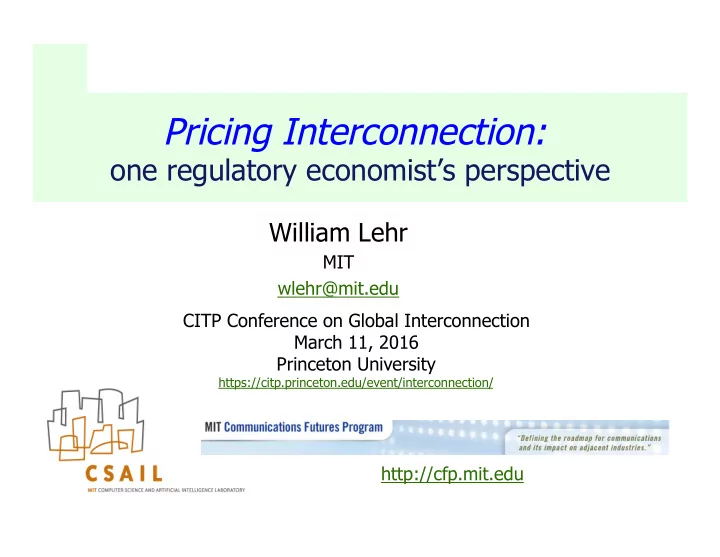

Pricing Interconnection: one regulatory economist’s perspective William Lehr MIT wlehr@mit.edu CITP Conference on Global Interconnection March 11, 2016 Princeton University https://citp.princeton.edu/event/interconnection/ http://cfp.mit.edu
Session #3: Pricing Interconnection Panel Discussion questions: • • What are the different ways of pricing Internet congestion? • What are the effects of data caps, pay-as-you-go pricing on Internet use? • How does zero-rating affect user demand for content or applications? Clarifying questions about what real issues are: • • Congestion or Usage-based. Retail or wholesale? • Who pays for broadband access? • How does state of competition (practical regulatory options) impact answers? • Is rise of traffic-sensitive costs the real question? Video & spectrum. 2
“Congestion” or Usage-based pricing? All pricing is demand sensitive, hence dynamic, Usage-based • • Typically multi-part : non-recurring, fixed ($/mo), usage ($/MB). • (Flat ($/mo) v. Usage ($/MB) is false price choice dichotomy…) • Dynamic: prices change w/ time, market conditions, but at what granularity (time, space, context)? Real-time pricing a special case. Prices serve two broad functions: • • Recover costs (Rev ≥ Cost), including fair return on capital. Costs are overwhelmingly fixed and/or shared (not incremental to individual subscriber). Most of pricing is and should be about this. • Signal: induce efficient behavior. (“congestion pricing to recover incremental capacity costs at peak”) Are we talking about retail or wholesale pricing? • • Retail: consumer demand behavior • Wholesale: industry supply behavior (interconnection) • Either Retail rate or Wholesale interconnection (rate) regulation. They’re substitutes. 3
Usage-based pricing? Tiered pricing way to go. Pay-as-you-go, data-caps, (zero-rating), etc. are ways to do • usage-based retail pricing. • Tools for price discrimination (and usually unavoidable!) What do consumers want? • • Lower prices, more choice, better quality (don’t we all!) • Also, Flat rates ó Simplicity (No hidden/unexpected charges) • Marginal cost per MB ~$0 (just use, don’t think about) What should consumers pay? • • Monthly bill should cover monthly cost of service. Most of that is contribution to fixed/shared costs (not incremental peak). • Solution (broadly): Tiered pricing. If consumers in correct tier, they should not be paying significant overage ($/MB) charges; and tiers should not be significantly priced above cost. Regulatory concerns? The usual…reg oversight still necessary • • Fairness/Access: Are (certain) consumers paying too much? • Supply-side: investment, efficiency (natural monopoly?), competition 4
Zero-rating a good idea? Yes, generally… Who pays how much for broadband? • • Internet is (at least) a 2-sided platform so reasonable that $ should flow in from both (all) sides potentially Zero-rating can lower retail prices for broadband access • • Can spur adoption, but may limit choice to subsidized content. • A mechanism for price discrimination, but that is not generally a problem for economists • But, risk of abuse for monopoly pricing or foreclosure, and that might induce us to build wrong-kind of Internet…. So need regulatory oversight. Which markets? • • Mature BB markets (US/EU)? Yes. Need scope to innovate in services. Want competition to work. • Developing BB markets (India, Brazil)? Yes. Need to increase access. 5
Do you want your Internet with or without Video? (work-in-progress, with Doug Sicker) How should Convergence proceed? • • Everything over IP (or single IP network) may not be right technical solution. • Everything over (one) Internet may not be the right regulatory or industry structure goal. Do we want media entertainment economics to drive how we • build the Internet? • Hollywood v. IoT (smart healthcare, green energy, ...) • It’s not that entertainment is not important, just that fundamental economic drivers are fundamentally different • Consumer attention/Liesure expenditures. Choice/taste ó bundling. • Content v. Conduit competition (and regulation) • Etc…. If all that entertainment video were NOT on Internet, would • we be thinking about these pricing questions differently?? 6
Summing up… Usage pricing ó Tiered pricing (retail) • • Need price discrimination for universal service • Should not ban, but need to monitor • Real-time congestion for consumers? Probably not… • Real-time resource allocation for wholesale? Yes. SDX IXPs, etc. Zero-rating ó Content Providers & Consumers can both pay • • Innovative services need flexible business models. When Netflix used USPO, they were paying for delivery. • Content-subsidies can promote access. • Should not ban, but need to monitor. Video driving Internet Traffic ó Entertainment Economics • • What does accommodating video mean for Internet? • With convergence, be careful what you wish for... Thanks for your attention! Bill Lehr (wlehr@mit.edu ) 7
Recommend
More recommend